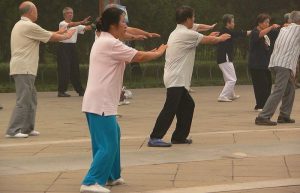Reduce Coronary Heart Disease Risk with Tai Chi
By John M. de Castro, Ph.D.
“tai chi is a promising and safe exercise alternative for patients with coronary heart disease who are unable or unwilling to attend traditional CR, in particular for older people, women, and deconditioned individuals.” – Elena Salmoirago‐Blotcher
Cardiovascular disease is the number one killer, claiming more lives than all forms of cancer combined. Lifestyle changes have proved to be quite effective in reducing the risk of cardiovascular disease. These include quitting smoking, weight reduction, improved diet, physical activity, and reducing stresses. Contemplative practices, such as meditation, tai chi, and yoga, have also been shown to be helpful for heart health. These practices have also been shown to be helpful for producing the kinds of other lifestyle changes needed such as smoking cessation, weight reduction and stress reduction.
Tai Chi and Qigong are ancient mindfulness practices involving slow prescribed movements. They are gentle and completely safe, can be used with the elderly and sickly, are inexpensive to administer, can be performed in groups or alone, at home or in a facility or even public park, and can be quickly learned. In addition, they can also be practiced in social groups without professional supervision. This can make it fun, improving the likelihood of long-term engagement in the practice. Since Tai Chi and Qigong are both mindfulness practices and exercises, they are particularly acceptable and effective methods to reduce the risk of cardiovascular disease.
In today’s Research News article “Tai Chi Improves Coronary Heart Disease Risk by Inactivating MAPK/ERK Pathway through Serum miR-126.” (See summary below or view the full text of the study at: https://www.ncbi.nlm.nih.gov/pmc/articles/PMC7199556/) Zhang and colleagues recruited coronary heart disease patients after release from the hospital following percutaneous coronary intervention (PCI). They were randomly assigned to either receive 90-minute daily Tai Chi training for 3 months or to receive exercise training of varied exercises calibrated to be equivalent to the Tai Chi practice. They were measured before and after training for body fat, epicardial adipose tissue volume, heart rate, blood pressure, quality of life, and balance performance. In addition, they were also measured for miR-126 and Mitogen-activated protein kinase (MAPK)-associated molecules in peripheral blood leukocytes.
They found that in comparison to baseline and the exercise control group, the group that received Tai Chi train had significantly lower body weight and body fat, epicardial adipose tissue volume, heart rate, systolic blood pressure, Serum miR-126, and MAPK signaling, and significantly greater balance stability and quality of life.
These results are particularly strong because the comparison condition was equivalent non-Tai Chi exercises. So, the results were not due simply to exercise but specifically to the practice of Tai Chi. The results suggest that Tai Chi practice greatly reduces risk factor for Coronary Heart Disease in patients recovering from percutaneous coronary intervention (PCI). In addition, since the miR-126 modulates the Mitogen-activated protein kinase (MAPK)-pathway that is associated with cardiovascular risk, Tai Chi practice also reduces a molecular pathway suggestive of cardiovascular risk.
These are impressive results that suggest that Tai Chi practice has substantial benefits for patients at-risk for cardiovascular disease. It improves the patients body composition, cardiovascular function, well-being, and even biochemical pathways associate with risk for coronary heart disease. This combined with the safety, convenience, low expense, and attractiveness of Tai Chi practice, makes it an ideal practice for the reduction of risk for coronary heart disease.
So, reduce coronary heart disease risk with Tai Chi.
“Tai chi offers other benefits as well for heart patients. The deep breathing enhances oxygen uptake, reducing the shortness of breath that’s also common with heart failure.” – Harvard Health Letter
CMCS – Center for Mindfulness and Contemplative Studies
This and other Contemplative Studies posts are also available on Google+ https://plus.google.com/106784388191201299496/posts and on Twitter @MindfulResearch
Study Summary
Zhang, G., Wang, S., Gu, Y., Song, L., Yu, S., & Feng, X. (2020). Tai Chi Improves Coronary Heart Disease Risk by Inactivating MAPK/ERK Pathway through Serum miR-126. Evidence-based complementary and alternative medicine : eCAM, 2020, 4565438. https://doi.org/10.1155/2020/4565438
Abstract
Background
Tai Chi is effective in preventing heart disease (CHD) risk, but the molecular mechanism remains unclear. Mitogen-activated protein kinase (MAPK) signaling plays a critical role in the pathogenesis of CHD and can be activated by miR-126. Tai Chi may exert its protective function through the miR-126-modulated MAPK pathway.
Methods
The CHD patients after PCI were randomized into the CG group (CG) (n = 19, normal care) and Tai Chi group (TG) (Tai Chi intervention, n = 17). Epicardial adipose tissue volume (EATV) (one main adverse cardiovascular event of CHD), HR (heart rate), QoL (quality of life) scores, and balance performance were measured in the two groups. The body fat content, abdominal subcutaneous fat, and visceral fat were measured to reflect the improvement of adipose tissue dysfunction. The levels of miR-126 and MAPK-associated molecules were measured in peripheral blood leukocytes. Meanwhile, the effects of miR-126 silence and mimic on MAPK-associated molecules were also explored in cardiac cell H9C2.
Results
After the 3-month intervention, Tai Chi reduced EATV and HR and increased QoL scores and balance performance, respectively (P < 0.05). The fat percentage, body fat mass, and BMI were also significantly reduced after Tai Chi intervention (P < 0.05). The levels of miR-126, MAPK, JNK, and ERK in the TG group were lower than those in the CG group (P < 0.05). The miR-126 levels had a strong relationship with the values of EATV, HR, and QoL scores (P < 0.05). miR-126 silence or mimic inactivated or activated MAPK-associated molecules in the cardiac cell lines.
Conclusions
Tai Chi improved CHD risk by inactivating the MAPK/ERK pathway via serum miR-126
https://www.ncbi.nlm.nih.gov/pmc/articles/PMC7199556/
